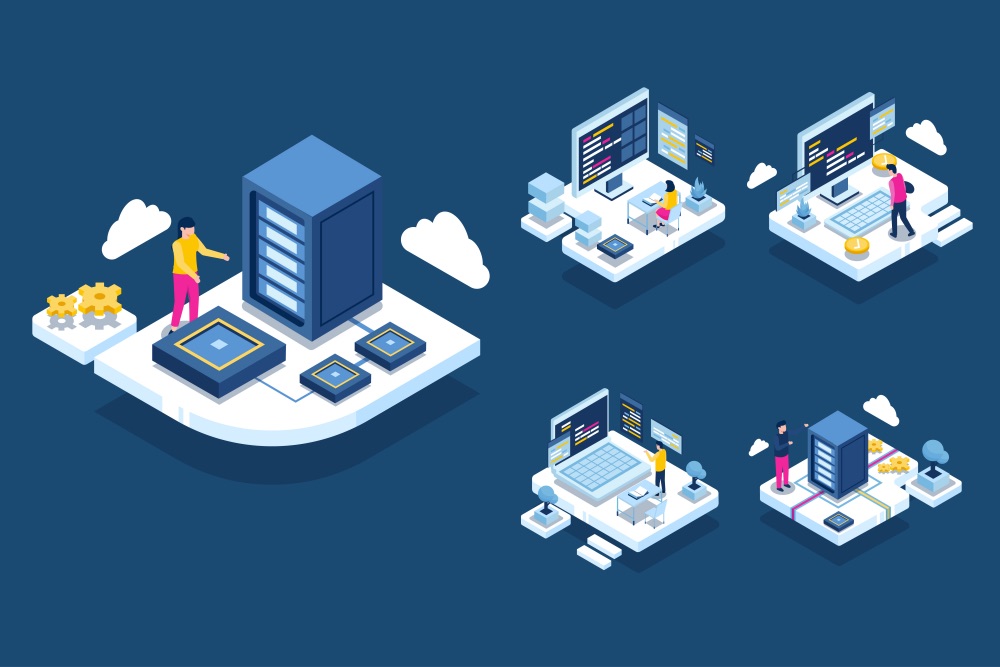Current trends suggest that more companies are looking at cloud-based solutions as an enabler for their outsourcing strategy. To keep up with business demands, organizations are migrating processes to the cloud, adding cloud-based third-party service providers to their business process chain. As outsourcing is becoming a mainstay, third-party vendor ecosystems are getting bigger and more complex. Data security risks emerging from third parties are a big concern for organizations. Businesses must therefore keep the third-party risk quotient in check.
By Prasad Sabbineni, Chief Technology Officer, MetricStream
Web hosting vector created by jcomp – www.freepik.com
The good news is that business decision-makers are generally aware of cyber risks in general. Independent surveys of C-suite executives indicated that most of them are aware of the risk landscape and close to half of those surveyed also expressed concern over cloud data security. But it was also found that not many leaders realised the degree of risks emerging from the third parties. In one survey, about 50% of the Indian CEOs who were interviewed said that they did not understand how a third-party data breach could impact their organization. For many business leaders, third-party risks continue to exist in a blind spot, emerging when they least expect it.
Why do organizations need visibility on third-party risk?
As companies continue to outsource, multiple vendors may get added to the business process. These range from cloud service providers and technology partners to sub-contractors and consultants. Of these, few vendors may have the cybersecurity checks and balances expected to keep cyber threats away. This potential chink in the armour makes the organization vulnerable to cyber-attacks. It is alarming to note that the number of vendor organizations without strong cyber defences is not small at all. A survey by an international research firm estimated that 51% of businesses have had a data breach through a vendor.
Apart from this, organizations are also exposed to intellectual property theft, asset poaching, corruption, financial, and operational risks. According to a multiyear Stanford University analysis, more than 90% of FCPA violations in the last 20 years involved a third party. Key decision makers need to get visibility on third-party risks as vendor risk can also become the organization’s risk, causing damage to reputation and revenue. Assessments, due diligence, and continuous monitoring of third-party risk is no longer an option, but a requirement.
A TPRM strategy backed by AI can help uncover third-party risk
A third-party risk management (TPRM) approach extends across the engagement lifecycle of every vendor within the organization and covers all functions. It is a framework that highlights aspects that determine the result of a third-party incident and the extent of damage caused by the exposure. Having a robust AI powered TPRM strategy can be very useful in uncovering potential risks from vendors.
TPRM frameworks are based on five key principles. These include identifying the third-party associations, classifying risks based on severity and urgency, assessing them in the context of the company’s overall risk appetite, managing these risks with set controls, and continuously monitoring compliance.
In the real world, a TPRM system should be able to track where an organization’s risks came from in the past and identify patterns in third-party vendors that may be responsible for these risks. It should be able to collate data from internal functions and map present vendor needs. It should also be able to vet vendors against organizational risk parameters within the TPRM framework itself and enable automation in selecting approved vendors.
Manual TPRM systems may have vetting, evaluation, onboarding, and continuous due diligence limitations. Effective real-time monitoring, alert processes, controls, and escalation protocols require an always-on, always vigilant intelligent system. AI-enabled TPRM platforms can ensure the application of these critical capabilities and more.
AI can be a powerful tool for companies dealing with multiple complex risks. Such platforms can help automate processes like allocating risk categories to vendors, risk quantification and risk reporting. Decision-makers and stakeholders can benefit from having single-window access to the risk profile of their third parties.
Also read:
MetricStream Collaborates with SASB Standards
Closing notes
In today’s age of digital wonders, AI can be used to clarify, process, and drive awareness of escalated risks across third-party vendors. It can be used to identify and prioritize cyber, operational, and financial risks more quickly and accurately than non-AI systems. Moreover, AI can help organizations gather and quantify risk intelligence efficiently and effectively, any time, all the time. In a world of interdependencies, AI is the best way organizations can get not just better visibility on third-party risks, but also to evaluate and effectively mitigate potential risks before they arise, securing critical vendor relationships.
This is a contributed article and the views expressed in this article are those of the writer.

